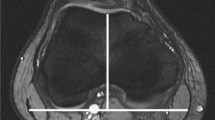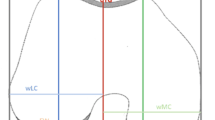Abstract
Purpose
Trochlear dysplasia is considered to be one of the major factors causing patellofemoral instability (PFI). Dejour’s classification is widely used to assess the severity of trochlear dysplasia. Additionally, in current literature, different quantitative parameters are recommended to distinguish between a normal trochlea and a dysplastic trochlea. In order to achieve a more objective evaluation of the trochlea, the aim of this study was to evaluate whether specific measurements of the femoral trochlea can be assigned to the qualitative classification system of Dejour.
Methods
Transverse MRI T2-weighted scans of 80 knees with symptomatic PFI and varying severity of trochlear dysplasia were classified according to Dejour (type A to D). For all MRI scans, quantitative measurements with parameters as described in the literature were applied. The values were then allocated to Dejour’s classification. In addition to the four-grade analysis, two-grade analysis was also performed (Dejour type A against type BCD). Dependent on the cut-off values, specificity, sensitivity and Youden index for each parameter was defined.
Results
The allocation resulted in the following distribution: type A trochlear dysplasia n = 25, type B n = 23, type C n = 18 and type D n = 14. In descriptive statistics, none of the measurements proposed in the literature could be assigned to the four-grade classification system of Dejour. For the two-grade analysis at the cut-off, sensitivity ranged from 75 to 86 % and specificity from 76 to 84 % for lateral trochlear inclination, trochlear facet asymmetry and depth of trochlear groove. All other measurements showed a poor sensitivity ranging from 49 to 67 % and specificity from 40 to 72 %. Interobserver and intraobserver repeatability for the measured parameters was fair to moderate (ICC values 0.34–0.58) in high-grade dysplasia (type BCD) and substantial to almost perfect (ICC values 0.71–0.88) in low-grade trochlear dysplasia (type A).
Conclusion
Quantitative measurements of the femoral trochlea have shown to be of limited value for the assessment of trochlear dysplasia. None of the quantitative measurements of the trochlea on transverse images could be assigned to the four-grade descriptive classification of trochlear dysplasia of Dejour. Additionally, measurements could not be reliably performed in high-grade trochlear dysplasia. However, trochlear inclination, trochlear facet asymmetry and depth of trochlear groove may help to distinguish between low-grade and high-grade dysplasia.
Level of evidence
II.






Similar content being viewed by others
References
Balcarek P, Ammon J, Frosch S (2010) Magnetic resonance imaging characteristics of the medial patellofemoral ligament lesion in acute lateral patellar dislocations considering trochlear dysplasia, patella alta and tibial tuberosity-trochlear groove distance. Arthroscopy 26:926–935
Biedert RM (2008) Osteotomien. Orthopäde 37:872–883
Biedert RM, Bachmann M (2009) Anterior-posterior trochlear measurements of normal and dysplastic trochlea by axial magnetic resonance imaging. Knee Surg Sports Traumatol Arthrosc 17:1225–1230
Carrillon Y, Abidi H, Dejour D, Fantino O, Moyen B, Tran-Minh VA (2000) Patellar instability: assessment on MR images by measuring the lateral trochlear inclination—initial experience. Radiology 216:582–585
Chhabra A, Subhawong TK, Carrino JA (2010) A systematised MRI approach to evaluating the patellofemoral joint. Skeletal Radiol 40:375–387
Colvin AC, West RV (2008) Current concepts review: patellar instability. J Bone Joint Surg Am 90:2751–2762
Dejour D, Le Coultre B (2007) Osteotomies in patello-femoral instabilities. Sports Med Arthrosc Rev 15:39–46
Dejour D, Saggin P (2010) The sulcus deepening trochleoplasty—the Lyon’s procedure. Int Orthop 34:311–316
Dejour H, Walch G, Nove-Josserand L, Guier CH (1994) Factors of patellar instability: an anatomic radiographic study. Knee Surg Sports Traumatol Arthrosc 2:19–26
Diederichs G, Issever AS, Scheffler S (2010) MR imaging of patellar instability: injury patterns and assessment of risk factors. Radiographics 30:961–981
Donell ST, Joseph G, Hing CB, Marshall TJ (2006) Modified Dejour trochleoplasty for severe dysplasia: operative technique and early clinical results. Knee 13:266–273
Fucentese SF, von Roll A, Koch PP, Epari DR, Fuchs B, Schottle PB (2006) The patella morphology in trochlear dysplasia: a comparative MRI study. Knee 13:145–150
Fucentese SF, Zingg PO, Schmitt J, Pfirrmann CW, Meyer DC, Koch PP (2011) Classification of trochlear dysplasia as predictor of clinical outcome after trochleoplasty. Knee Surg Sports Traumatol Arthrosc 19:1655–1661
Koeter S, Bongers EM, de Rooij J, van Kampen A (2006) Minimal rotation aberrations cause radiographic misdiagnosis of trochlear dysplasia. Knee Surg Sports Traumatol Arthrosc 14:713–717
Lippacher S, Dejour D, Elsharkawi M, Dornacher D, Ring C, Dreyhaupt J, Reichel H, Nelitz M (2012) Observer agreement on the Dejour trochlea dysplasia classification. A comparison of true lateral radiographs to axial magnetic resonance images. Am J Sports Med 40:837–843
Nelitz M, Theile M, Dornacher D, Wölfle J, Reichel H, Lippacher S (2012) Analysis of failed surgery for patellar instability in children with open growth plates. Knee Surg Sports Traumatol Arthrosc 20:822–828
Pfirrmann CW, Zanetti M, Romero J, Hodler J (2000) Femoral trochlear dysplasia: MR findings. Radiology 216:858–864
Redziniak DE, Diduch DR, Mihalko WM et al (2009) Patellar instability. J Bone Joint Surg Am 91:2264–2275
Salzmann GM, Weber TS, Spang JT, Imhoff AB, Schöttle PB (2010) Comparison of native axial radiographs with axial imaging for the determination of the trochlear morphology in patients with trochlear dysplasia. Arch Orthop Trauma Surg 130:335–340
Schoettle PB, Fucentese SF, Pfirrmann C, Bereiter H, Romero J (2005) Trochleaplasty for patellar instability due to trochlear dysplasia: a minimum 2 year clinical and radiological follow-up of 19 knees. Acta Orthop 76:693–698
Tecklenburg K, Feller JA, Whitehead TS, Webster KE, Elzarka A (2010) Outcome of surgery for recurrent patellar dislocation based on the distance of the tibial tuberosity to the trochlear groove. J Bone Joint Surg Br 92:1376–1380
Toms AP, Cahir J, Swift L, Donell ST (2009) Imaging the femoral sulcus with ultrasound, CT, and MRI: reliability and generalizability in patients with patellar instability. Skeletal Radiol 38:329–338
Van Huyssteen AL, Hendrix MRG, Barnett AJ, Wakeley CJ, Eldridge JDJ (2006) Cartilage-bone mismatch in the dysplastic trochlea: an MRI study. J Bone Joint Surg Br 88:688–691
Walch G, Dejour H (1989) Radiology in femoropatellar pathology. Acta Orthop Belg 55:371–380
Author information
Authors and Affiliations
Corresponding author
Rights and permissions
About this article
Cite this article
Nelitz, M., Lippacher, S., Reichel, H. et al. Evaluation of trochlear dysplasia using MRI: correlation between the classification system of Dejour and objective parameters of trochlear dysplasia. Knee Surg Sports Traumatol Arthrosc 22, 120–127 (2014). https://doi.org/10.1007/s00167-012-2321-y
Received:
Accepted:
Published:
Issue Date:
DOI: https://doi.org/10.1007/s00167-012-2321-y




